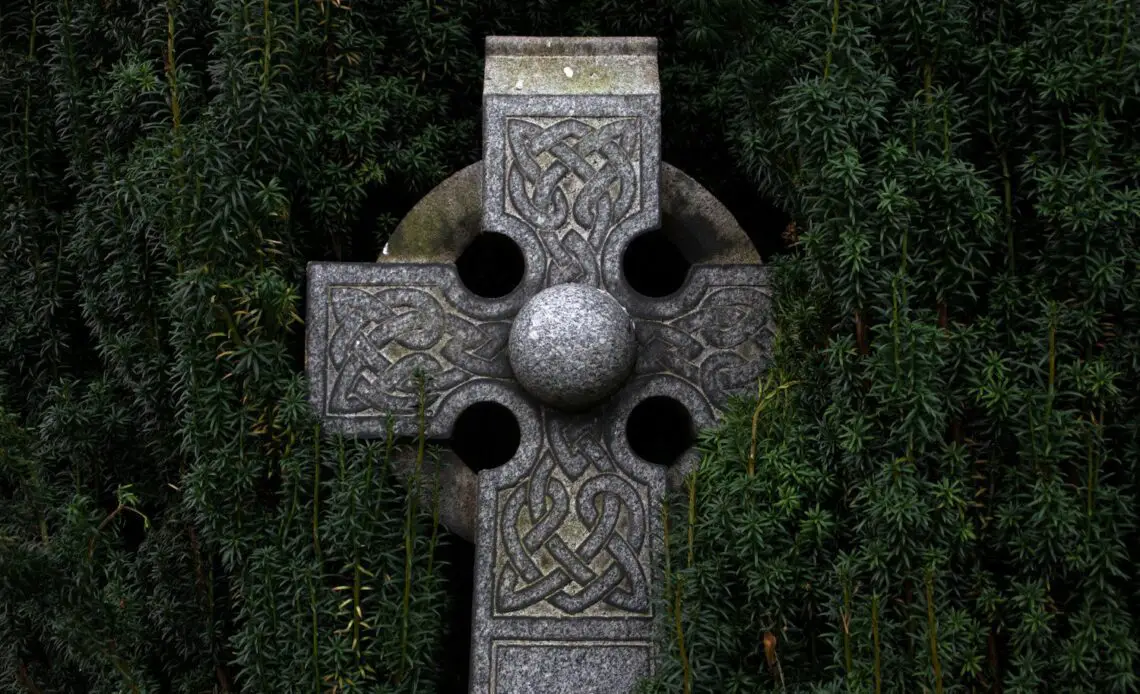
Deep peace of the Running Wave to you. Deep peace of the Flowing Air to you. Deep peace of the Quiet Earth to you. Deep peace of the Shining Stars to you. Deep peace of the Son of Peace to you.
A Celtic Benediction- Friends of Silence January 1996 (Vol. IX. No. 1)
Celtic spirituality offers a deep sense of meaning in the mystery and presence of God in all of His creations. It welcome hope and happiness each day.
This article provides insight into the wonders of Celtic spirituality and how it can guide you in your spiritual path.
What is Celtic Spirituality?
According to M.J. Drake Spaeth, Celtic spirituality is a contemporary term that involves Ancient Celtic traditions, practices, values, attitudes, and beliefs.
It refers to practices and beliefs in Ireland, Wales, and Scotland, developed in the early fifth century when monastic tradition emerged, as explained by Christine Valters Paintner.
On the other hand, Unity College explained that Celtic spirituality offers a deep sense of meaning in the mystery and presence of God in all of His creations. It leads one to maintain stillness and listen to the needs of others.
Celtic spirituality reminds us of our obligation to reciprocate all the blessings we receive by helping our fellow humans and becoming a ray of light for them.
History of Celtic Spirituality
According to The Celtic Center, Roman political and religious systems didn’t reach the Celts or the Celtic people of Northwestern Europe as they were out of reach from the Roman Empire.
The Celts were an indigenous race that lived in groups across Northern Europe from pre-500 BC up to the Medieval Period.
Because of their isolation, the Celts preserved their ancient practices attributed to nature and their community’s dignity, their colorful and poetic imagination, and equality among genders, which served as their guide in understanding God and all His creations.
As Christianity arrived, the Celtic people were able to beautifully incorporate their ancient beliefs and practices into that of Christianity.
Paintner added that much of Celtic Christianity is strongly characterized by incarnational theology. It emphasizes the sacramentality of all creations through vivid art forms and metalworks.
The Celtic Center also explained that the Celts saw the presence of the Spirit and the Divine in all situations. They maintained a sacred and strong connection with nature.
Most importantly, they preserved profound spiritual practices such as meditation, prayer, communicating with nature, hospitality, compassion, and art.
Themes of Celtic Spirituality
Pilgrimage
Based on Lori Erickson’s article, For the early monks in the Celtic regions, a pilgrimage was closely linked to the idea of penance in Christianity.
Initially, it meant that these monks would seek out a place where God would be revealed to them, and they would embark on these journeys. It was meant to be a way to discover someone’s path to God.
Along the way, they would leave signs of their journey, the most common being a pilgrim stone. The pilgrim stone came in many forms – a coarsely carved cross being an example.
Another sign of pilgrimage is the round towers which you can see across Ireland. These towers served many purposes – some common uses were as places of refuge during attacks or bell towers.
However, they were also extremely vital in providing pilgrims with direction and inspiration as they moved along in their journeys of actualization.
Moving to the idea of pilgrimages, Eric Berger explained the appeal of Celtic Spirituality in both Pagans and Christians. This is through the spiritual fulfillment spent extracting peace from your surroundings.
He even states that there is a simple Celtic discipline of listening for the divine in one’s environment.
“Early Celtic Christians esteemed the biblical figure John the Beloved, who was said to have been still enough to hear the heartbeat of Jesus,” Berger added.
As a result, the environment houses the divine and causes this to be a very integral part of Celtic Spirituality.
Connection to the Environment
In the study of Graham Duncan in 2015, An idea that stemmed from the pilgrimage is that people searching for God turn to their environment and guide themselves through it to find the divine.
However, while this acts as a journey, Celtic spirituality emphasizes the significance of their environment as a vessel of God’s presence.
Simply put, it means that God is all around us. Duncan points out a few major points about Celtic Christianity and its relation to the environment.
These are the love of God’s creation, care for the environment, and closeness between the natural and supernatural (immanence and transcendence or ibid.).
This expresses how closely God and the environment are connected because they are constantly around us. At the same time, we are reminded of our duty as protectors of nature.
Community and Monasticism
After looking at the environment which surrounds us, the next logical theme of Celtic Spirituality is community.
The Celts had a disposition for forming communities, living together, and amongst each other. They felt a natural connection with saints and angels. And as a result, this complemented the kinship they felt for one another.
It seemed a natural and ordinary way to live a Christian life when they shared their lives in communities and monasteries.
It’s worth noting that much Celtic Mythology comes from their folklore and their attachment to any living thing around them. It only seems logical that this would transcend the spiritual paths they choose.
Furthermore, The Celtic Center added that the Celts believed in the equal power of men and women in leading, inspiring, and participating in all aspects of spiritual and community practice.
They believe in the magnificent tradition of having an Anam Cara or soul-friend who will walk with you throughout your spiritual journey.
Design and Symbols
Lastly, we look at the major symbols which signify Celtic Spirituality. Keith O’Hara explained that Celtic symbols arrived in Ireland with the Celts.
The Celts lived in small tribal communities, and despite their differing groups, they shared a similar Celtic language and plenty of cultural symbols.
One of the known groups among the ancient Celtic people is the Druids. The Druids are among the learned, law-keeping, and high-ranking class of the Celts.
As a result, the Druids have contributed and were commonly related to many of the known Celtic symbols today. Here are 10 Celtic Symbols and their meaning according to Keith O’Hara.
| Symbol | Meaning |
| The Celtic Tree of Life. | Symbolizes strength, Longevity, and Wisdom. |
| The Celtic Cross. | While the Celtic cross is a Christian symbol, we can trace its roots back to ancient pagan beliefs before Christianity arrived in Ireland. There are many theories about the meaning of the Celtic cross. One is that its four arms represent the cardinal directions (North, South, East, and West). |
| The Ailm. | Symbolizes strength, endurance, and resilience. |
| The Triskelion. | Represents progress or the three stages of life (birth, death, and rebirth). |
| The Triquetra or Trinity Knot. | The Celtic symbol for the family. It is also believed to be one of the oldest symbols of spirituality. |
| The Dara Knot. | The ancient Celts used the Dara knot to call upon inner strength and wisdom. |
| The Shamrock. | The Shamrock is the national flower of Ireland. It is believed to represent the triad and was used by St. Patrick when he taught about the unity of the Holy Trinity to the Ancient Celtic Pagans. |
| The Serch Bythol. | Represents the everlasting love between two people. |
| The Celtic Motherhood Knot. | Represents motherhood and the eternal connection between a mother and her child. |
| The Awen. | The Awen represents creativity and the harmony of opposites in the universe. |
Final Thoughts
Trevor Miller reflects that the heart of Celtic spirituality was all about living your life, following your path, and traveling your journey despite its ordinariness. It’s about appreciating and learning from life’s pain, pleasure, hopes, heartaches, disappointments, and dreams.
The spiritual path is not always made of flowers. Sometimes it’s muddy, thorny, and seems impossible to walk on. But Celtic spirituality reminds you that you don’t have to go on your journey alone.
In each person you’ll meet, you can always find a soul friend with whom you can hold hands and go on an adventure toward your spiritual destination.
The key here is to seek and always see the good in others.
Discover More About Spirituality
Guides
- 23 Best Spiritual Books to Enrich Your Soul
- Celtic Spirituality: A Quick Read
- Demons and Demonic Possessions: Everything You Need To Know
- Esoteric Spirituality: An Introduction
- Shinto Spirituality: Everything You Need To Know
- Spiritual Awakening: The Complete Guide
- Spiritual Caregiving: Your Complete Guide
- Spiritual Confusion: What It Is, Causes & How To Overcome It
- Spiritual Counseling: Everything You Need To Know
- Spiritual Death: Everything You Need To Know
- Spiritual Emptiness: 10 Signs & 11 Ways to Overcome It
- Spiritual Grounding: A Quick Guide
- Spiritual Health: A Comprehensive Guide
- Spiritual Illness: Everything You Need To Know
- Spiritual Meditation (A Guide to Strengthen Your Spirit)
- Spiritual Resilience: The Skill to Overcome Hardships
- The Divine Feminine (A Complete Insight and Ways to Unlock It)
- What Is Spirituality? Your Complete Guide
How To
- 12 Ways To Attain Spiritual Maturity
- 13 Ways to Spiritually Cleanse Yourself
- 7 Healthy Ways to Deal With Anger
- 9 Ways to Spiritually Connect With Nature (A Quick Read)
- How To Be Spiritually Minded (Your Complete Guide To Spiritual Mindedness)
- How to Become A Spiritual Person (23 Ways & 7 Signs)
- How To Build Your Meditation Garden (An Easy Guide)
- How To Connect With The Universe (Everything You Need To Know)
- How To Form A Deeper Connection With God
- How to Heal Your Sacral Chakra (A Quick Guide)
- How to Incorporate Anglican Spirituality In Your Life (A Quick Guide)
- How to Lead a Spiritual Life: 13 Steps and Benefits
- How to Raise a Spiritual Child (Complete Tips and Signs for Parents)
- How To Remove Someone From Your Life (Signs and Ways to Break Free from Toxic Relationships)
- How to Spiritually Attract Money (A Complete Guide)
Signs
Questions
- God Loves The Broken: How Does Spiritual Brokenness Bring Us Closer to God?
- How Are Spirituality and Science Related? The Two Hands of a Clock (A Quick Read)
- How Does Spirituality Affect The Lives of Millennials? (A Quick Read)
- What Does ‘I am with You in Spirit’ Mean? (Explained)
- What Is Agnosticism? (Explained)
